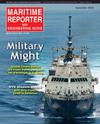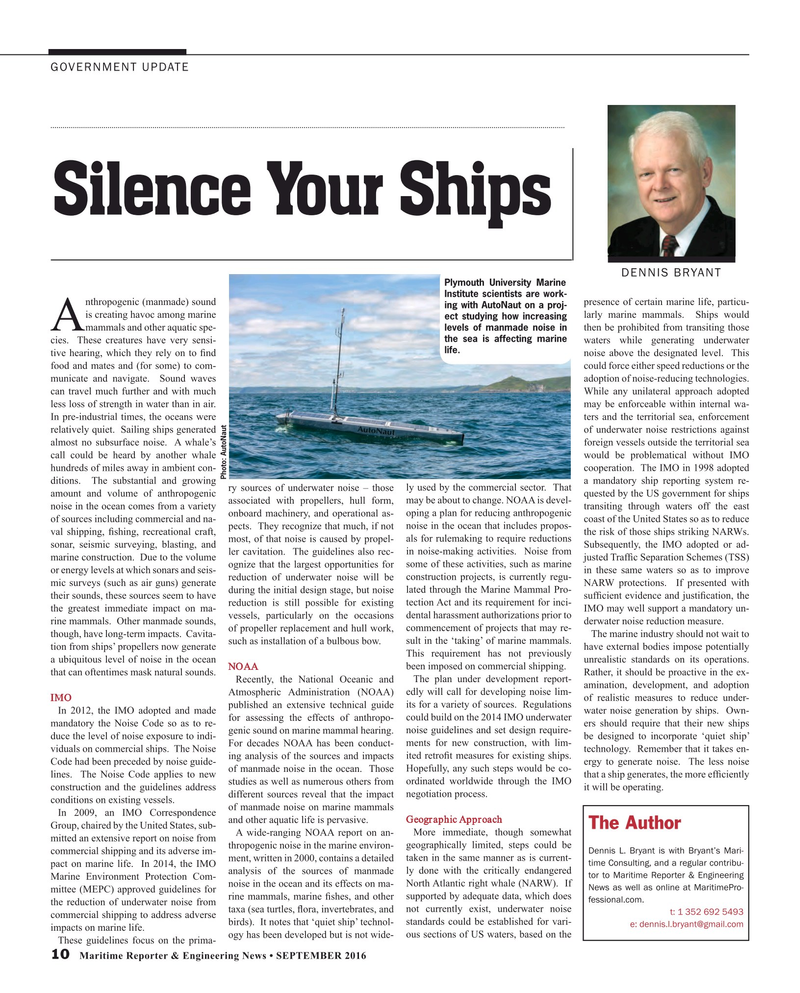
Page 10: of Maritime Reporter Magazine (September 2016)
Maritime & Ship Security
Read this page in Pdf, Flash or Html5 edition of September 2016 Maritime Reporter Magazine
GOVERNMENT UPDATE
Silence Your Ships
DENNIS BRYANT
Plymouth University Marine
Institute scientists are work- nthropogenic (manmade) sound presence of certain marine life, particu- ing with AutoNaut on a proj- is creating havoc among marine larly marine mammals. Ships would ect studying how increasing mammals and other aquatic spe- then be prohibited from transiting those
A levels of manmade noise in the sea is affecting marine cies. These creatures have very sensi- waters while generating underwater life. tive hearing, which they rely on to ? nd noise above the designated level. This food and mates and (for some) to com- could force either speed reductions or the municate and navigate. Sound waves adoption of noise-reducing technologies. can travel much further and with much While any unilateral approach adopted less loss of strength in water than in air. may be enforceable within internal wa-
In pre-industrial times, the oceans were ters and the territorial sea, enforcement relatively quiet. Sailing ships generated of underwater noise restrictions against almost no subsurface noise. A whale’s foreign vessels outside the territorial sea call could be heard by another whale would be problematical without IMO hundreds of miles away in ambient con- cooperation. The IMO in 1998 adopted
Photo: AutoNaut ditions. The substantial and growing ry sources of underwater noise – those ly used by the commercial sector. That a mandatory ship reporting system re- amount and volume of anthropogenic associated with propellers, hull form, may be about to change. NOAA is devel- quested by the US government for ships noise in the ocean comes from a variety transiting through waters off the east onboard machinery, and operational as- oping a plan for reducing anthropogenic of sources including commercial and na- coast of the United States so as to reduce val shipping, ? shing, recreational craft, pects. They recognize that much, if not noise in the ocean that includes propos- the risk of those ships striking NARWs. sonar, seismic surveying, blasting, and most, of that noise is caused by propel- als for rulemaking to require reductions
Subsequently, the IMO adopted or ad- ler cavitation. The guidelines also rec- in noise-making activities. Noise from marine construction. Due to the volume justed Traf? c Separation Schemes (TSS) ognize that the largest opportunities for some of these activities, such as marine or energy levels at which sonars and seis- in these same waters so as to improve reduction of underwater noise will be construction projects, is currently regu- mic surveys (such as air guns) generate NARW protections. If presented with during the initial design stage, but noise lated through the Marine Mammal Pro- their sounds, these sources seem to have suf? cient evidence and justi? cation, the reduction is still possible for existing tection Act and its requirement for inci- the greatest immediate impact on ma- IMO may well support a mandatory un- vessels, particularly on the occasions dental harassment authorizations prior to rine mammals. Other manmade sounds, derwater noise reduction measure.
of propeller replacement and hull work, commencement of projects that may re- though, have long-term impacts. Cavita- The marine industry should not wait to such as installation of a bulbous bow. sult in the ‘taking’ of marine mammals. tion from ships’ propellers now generate This requirement has not previously have external bodies impose potentially a ubiquitous level of noise in the ocean unrealistic standards on its operations.
NOAA been imposed on commercial shipping.
that can oftentimes mask natural sounds. Rather, it should be proactive in the ex-
Recently, the National Oceanic and The plan under development report- amination, development, and adoption
Atmospheric Administration (NOAA) edly will call for developing noise lim-
IMO of realistic measures to reduce under-
In 2012, the IMO adopted and made published an extensive technical guide its for a variety of sources. Regulations water noise generation by ships. Own- for assessing the effects of anthropo- could build on the 2014 IMO underwater mandatory the Noise Code so as to re- ers should require that their new ships genic sound on marine mammal hearing. noise guidelines and set design require- duce the level of noise exposure to indi- be designed to incorporate ‘quiet ship’
For decades NOAA has been conduct- ments for new construction, with lim- viduals on commercial ships. The Noise technology. Remember that it takes en- ing analysis of the sources and impacts ited retro? t measures for existing ships.
Code had been preceded by noise guide- ergy to generate noise. The less noise lines. The Noise Code applies to new of manmade noise in the ocean. Those Hopefully, any such steps would be co- construction and the guidelines address studies as well as numerous others from ordinated worldwide through the IMO that a ship generates, the more ef? ciently it will be operating.
different sources reveal that the impact negotiation process.
conditions on existing vessels.
In 2009, an IMO Correspondence of manmade noise on marine mammals and other aquatic life is pervasive. Geographic Approach
Group, chaired by the United States, sub-
The Author
A wide-ranging NOAA report on an- More immediate, though somewhat mitted an extensive report on noise from thropogenic noise in the marine environ- geographically limited, steps could be
Dennis L. Bryant is with Bryant’s Mari- commercial shipping and its adverse im- time Consulting, and a regular contribu- pact on marine life. In 2014, the IMO ment, written in 2000, contains a detailed taken in the same manner as is current- analysis of the sources of manmade ly done with the critically endangered tor to Maritime Reporter & Engineering
Marine Environment Protection Com- noise in the ocean and its effects on ma- North Atlantic right whale (NARW). If
News as well as online at MaritimePro- mittee (MEPC) approved guidelines for fessional.com. the reduction of underwater noise from rine mammals, marine ? shes, and other supported by adequate data, which does taxa (sea turtles, ? ora, invertebrates, and not currently exist, underwater noise t: 1 352 692 5493 commercial shipping to address adverse birds). It notes that ‘quiet ship’ technol- standards could be established for vari- e: [email protected] impacts on marine life. ogy has been developed but is not wide- ous sections of US waters, based on the
These guidelines focus on the prima- 10 Maritime Reporter & Engineering News • SEPTEMBER 2016
MR #9 (10-17).indd 10 9/2/2016 10:09:01 AM

 9
9

 11
11
